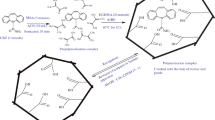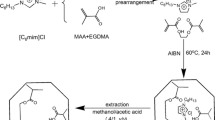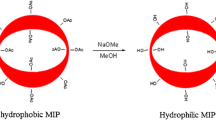Abstract
Coumarin, 7-hydroxycoumarin and dicoumarol molecularly imprinted polymers (MIP) were synthesized by bulk polymerization. Methacrylic acid and 4-vinylpyridine were tested as functional monomers and methanol, ethanol, acetonitrile, toluene and chloroform were tested as porogens. The binding capabilities of the imprinted polymers were assessed by equilibrium binding analysis. Highest binding capacity was obtained for MIP prepared for the template 7-hydroxycoumarin synthesized in methacrylic acid as functional monomer, chloroform as porogen and methanol/water as analyte solvent. Scanning electron microscopy analysis documented its appropriate morphology. ATR-FTIR spectra confirmed successful polymerization of MIP. Coumarin structural analogues were employed to evaluate the polymer selectivity and it was found that polymer prepared for 7-hydroxycoumarin was selective for its template molecule. Kinetic studies showed relatively fast adsorption of analytes to MIPs (1 h). Rebinding properties of MIPs were evaluated by adsorption isotherms. The calculated data fitted well with experimental data showing that Freundlich isotherm is suitable for modelling the adsorption of tested coumarins on prepared MIPs. Applicability of polymer prepared for 7-hydroxycoumarin was tested for the selective extraction of coumarins from the sample of chicory.






Similar content being viewed by others
References
Rezaee R, Behravan J, Soltani F, Naderi Y, Emami B, Iranshahi M (2014) Antigenotoxic activities of the natural dietary coumarins umbelliferone, herniarin and 7-isopentenyloxy coumarin on human lymphocytes exposed to oxidative stress. Drug Chem Toxicol 37:144–148
Skalicka-Woźniak K, Orhan I, Cordell GA, Nabavi SM, Budzyńska B (2016) Implication of coumarins towards central nervous system disorders. Pharmacol Res 103:188–203
Ali MY, Jannat S, Jung HA, Choi RJ, Roy A, Choi JS (2016) Anti-Alzheimer’s disease potential of coumarins from Angelica decursiva and Artemisia capillaris and structure-activity analysis. Asian Pac J Trop Med 9:103–111
Gomez-Verjan JC, Estrella-Parra E, Vazquez-Martinez ER, Gonzalez-Sanchez I, Guerrero-Magos G, Mendoza-Villanueva D, Isus L, Alfaro A, Cerbón-Cervantes M, Aloy P, Reyes-Chilpa R (2016) Risk assessment of Soulatrolide and Mammea (A/BA + A/BB) coumarins from Calophyllum brasiliense by a toxicogenomic and toxicological approach. Food Chem Toxicol 91:117–129
Waksmundzka-Hajnos M, Petruczynik A, Hajnos ML, Tuzimski T, Hawryl A, Bogucka-Kocka A (2006) Two-dimensional thin-layer chromatography of selected coumarins. J Chromatogr Sci 44:510–517
Blahová J, Svobodová Z (2012) Assessment of coumarin levels in ground cinnamon available in the Czech retail market. Sci World J 2012:1–4
Orhan I (2012) Biotechnological production of plant secondary metabolites. Ankara, Turkey
Lacy A, O’Kennedy R (2004) Studies on coumarins and coumarin-related compounds to determine their therapeutic role in the treatment of cancer. Curr Pharm Des 10:3797–3811
Kyzas GZ, Bikiaris DN (2014) Molecular imprinting for high-added value metals: an overview of recent environmental applications. Adv Mater Sci Eng 2014:1–8
Ruizhuo O, Jianping L, Huangxian J (2010) Artificial receptor-functionalized nanoshell: facile preparation, fast separation and specific protein recognition. Nanotechnology 21:1–9
Li P, Wang T, Lei F, Tang P, Tan X, Liu Z, Shen L (2014) Rosin-based molecularly imprinted polymers as the stationary phase in high-performance liquid chromatography for selective separation of berberine hydrochloride. Polym Int 63:1699–1706
Thoelen R, Vansweevelt R, Duchateau J, Horemans F, D´Haen J, Lutsen L, Vanderzande D, Ameloot M, Vande Ven M, Cleij TJ, Wagner P (2008) A MIP-based impedimetric sensor for the detection of low-MW molecules. Biosens Bioelecton 23:913–918
Hu SG, Li L, He XW (2005) Solid-phase extraction of esculetin from the ash bark of Chinese traditional medicine by using molecularly imprinted polymers. J Chromatogr A 1062:31–37
Walshe M, Howarth J, Kelly MT, O´Kennedy R, Smyth MR (1997) The preparation of a molecular imprinted polymer to 7-hydroxycoumarin and its use as a solid-phase extraction material. J Pharm Biomed Anal 16:319–325
Li Y, Li X, Li Y, Dong C, Jin P, Qi J (2009) Selective recognition of veterinary drugs residues by artificial antibodies designed using a computational approach. Biomaterials 30:3205–3211
He JX, Fang GZ, Yao YC, Wang S (2010) Preparation and characterization of molecularly imprinted silica monolith for screening sulfamethazine. J Sep Sci 33:3263–3271
Pérez-Moral N, Mayes G (2004) Comparative study of imprinted polymer particles prepared by different polymerisation methods. Anal Chim Acta 504:15–21
Kumar R, Agrawal YK (2014) Analytical strategies for characterization of molecular imprinted polymers: a current review. Int J Chem Tech Res 6:1162–1167
Hamdaoui O, Naffrechoux E (2007) Modeling of adsorption isotherms of phenol and chlorophenols onto granular activated carbon. Part I. Two-parameter models and equations allowing determination of thermodynamic parameters. J Hazard Mater 147:381–394
Wang TH, Li MH, Yeh WCh, Wei YY, Teng SP (2008) Removal of cesium ions from aqueous solution by adsorption onto local Taiwan laterite. J Hazard Mater 160:638–642
Spevak A, Hroboňová K (2014) Group-selective molecularly imprinted polymer as a sorbent for extraction of coumarins from medicinal plants. Chem Listy 108:251–255
Hroboňová K, Spevak A, Spišská Ľ, Lehotay J, Čižmárik J (2013) Application of umbelliferone molecularly imprinted polymer in analysis of plant samples. Chem Papers 67:477–483
Kyzas GZ, Bikiaris DN, Lazaridis NK (2009) Selective separation of basic and reactive dyes by molecularly imprinted polymers (MIPs). Chem Eng J 149:263–272
Limousin G, Gaudet JP, Charlet L, Szenknect S, Barthés V, Krimissa M (2007) Sorption isotherms: a review on physical bases, modeling and measurement. Appl Geochem 22:249–275
Desta MB (2013) Batch sorption experiments: Langmuir and Freundlich isotherm studies for the adsorption of textile metal ions onto Teff Straw (Eragrostistef) agricultural waste. J Thermodynamics 2013:1–6
Acknowledgements
This work was financially supported by the Slovak Research and Development Agency under the contract no. APVV-15-0355.
Author information
Authors and Affiliations
Corresponding author
Ethics declarations
Conflict of interest
The authors declare that our research is in compliance with ethical standards, there is no conflict of interest regarding the publication of this paper, and our research did not involve human participants or animals.
Electronic supplementary material
Below is the link to the electronic supplementary material.
Rights and permissions
About this article
Cite this article
Machyňáková, A., Hroboňová, K. Synthesis and Evaluation of Molecularly Imprinted Polymers as Sorbents for Selective Extraction of Coumarins. Chromatographia 80, 1015–1024 (2017). https://doi.org/10.1007/s10337-017-3325-z
Received:
Revised:
Accepted:
Published:
Issue Date:
DOI: https://doi.org/10.1007/s10337-017-3325-z




